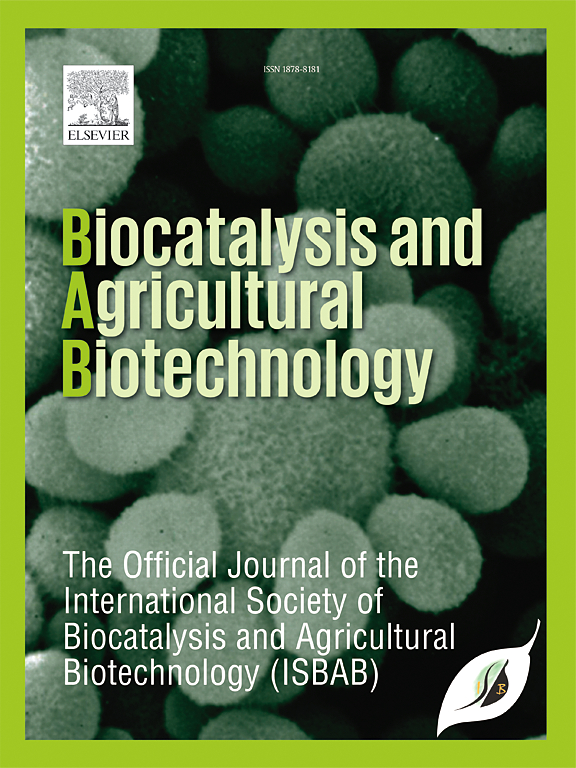Investigation of glutamic acid production capacity of Stenotrophomonas sp. strain CG2 isolated from soil
IF 3.8
Q2 BIOTECHNOLOGY & APPLIED MICROBIOLOGY
引用次数: 0
Abstract
Glutamic acid is a widely used amino acid in the food and pharmaceutical industries due to its role as a flavor enhancer and a metabolic precursor. This study aimed to identify glutamic acid-producing bacterial strains from soil samples collected across different regions. Among 262 isolates screened, Stenotrophomonas sp. strain CG2 exhibited the highest production capacity and was identified through 16S rRNA sequencing. Fermentation parameters including pH, temperature, incubation time, and agitation speed were optimized using the Plackett–Burman design, leading to a maximum yield of 3.76 ± 0.65 g/L under optimized conditions (pH 7.0, 30 °C, 200 rpm, 84 h), compared to 2.72 g/L in unoptimized TSB medium. The produced glutamic acid was purified using ion-exchange resin, yielding a recovery efficiency of 53.48 ± 3.28 %, and its identity was confirmed by FT-IR, RAMAN, and LC-MS/MS analysis.
This study is among the first to systematically explore Stenotrophomonas spp. for glutamic acid biosynthesis under optimized fermentation conditions. The results provide insight into the strain's specific responses to nutrient composition, revealing its potential for future biotechnological applications. By expanding the microbial landscape of amino acid producers, this work offers a foundation for using CG2 in sustainable bioproduction processes, particularly those leveraging food or agro-industrial waste streams.
土壤中窄养单胞菌CG2产谷氨酸能力的研究
谷氨酸是一种广泛应用于食品和制药工业的氨基酸,因为它具有增强风味和代谢前体的作用。本研究旨在从不同地区收集的土壤样品中鉴定出产谷氨酸的细菌菌株。在筛选的262株分离株中,窄养单胞菌CG2具有最高的生产能力,并通过16S rRNA测序鉴定。采用Plackett-Burman设计优化发酵参数,包括pH、温度、培养时间和搅拌速度,优化条件下(pH 7.0, 30°C, 200 rpm, 84 h)的最大产量为3.76±0.65 g/L,而未优化的TSB培养基的最大产量为2.72 g/L。采用离子交换树脂对所得谷氨酸进行纯化,回收率为53.48±3.28%,经FT-IR、RAMAN和LC-MS/MS分析证实其同源性。本研究是首次系统探索窄养单胞菌在优化发酵条件下的谷氨酸生物合成。研究结果揭示了该菌株对营养成分的特定反应,揭示了其未来生物技术应用的潜力。通过扩大氨基酸生产者的微生物景观,这项工作为在可持续生物生产过程中使用CG2提供了基础,特别是那些利用食品或农业工业废物流的生物生产过程。
本文章由计算机程序翻译,如有差异,请以英文原文为准。
求助全文
约1分钟内获得全文
求助全文
来源期刊

Biocatalysis and agricultural biotechnology
Agricultural and Biological Sciences-Agronomy and Crop Science
CiteScore
7.70
自引率
2.50%
发文量
308
审稿时长
48 days
期刊介绍:
Biocatalysis and Agricultural Biotechnology is the official journal of the International Society of Biocatalysis and Agricultural Biotechnology (ISBAB). The journal publishes high quality articles especially in the science and technology of biocatalysis, bioprocesses, agricultural biotechnology, biomedical biotechnology, and, if appropriate, from other related areas of biotechnology. The journal will publish peer-reviewed basic and applied research papers, authoritative reviews, and feature articles. The scope of the journal encompasses the research, industrial, and commercial aspects of biotechnology, including the areas of: biocatalysis; bioprocesses; food and agriculture; genetic engineering; molecular biology; healthcare and pharmaceuticals; biofuels; genomics; nanotechnology; environment and biodiversity; and bioremediation.
 求助内容:
求助内容: 应助结果提醒方式:
应助结果提醒方式:


